Gas street lamps in the past
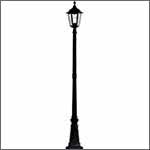
Street lamps were powered by gas before the mid-20th Century. This page explains and illustrates how they worked using a feature called a gas mantle and describes their light. Council street lamps were on lampposts, but some street lighting also came from gas lamps outside shops, provided by the shops to light their window displays and as a service to customers. The page is brought to life with contributions from people who were alive at the time and lived with gas street lighting.
____
Extracted from the memoirs of the webmaster's mother (1906-2002) and edited by the webmaster with further research and firsthand contributions from others
When I was a child in the early 1900s, street lights were on lampposts like today, but they were not at all like today's. They ran on gas and were lit by teams of lamplighters.
How gas street lights worked
The street gas lights worked the same way as the house gas lights in that the flame from the lighted gas heated up mantles which became incandescent and gave out light.
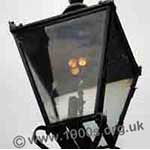
Three mantles in a gas street lamp. Photographed in Blists Victorian Town
Street lights gave out more light than house lights because there were more gas jets to a lamp, each with its own mantle. When the mantles needed replacing, which was more often than they actually were replaced, the light flickered so that shadows seemed to move.
The light from the street lamps
The light from the gas street lamps was greenish, eerie and flickering. Both my father and I on separate occasions thought we saw a woman ghost in our front bedroom, but I didn't want to think of such things and put it down to the eeriness of the flickering shadows.
contributed by Peter Johnson, childhood observation
Gas street lamps gave out a circle of light which didn't spread far. In between the lamp posts was dark.
Clockwork timers for gas street lamps
contributed by Peter Johnson, childhood observation
Shortly after the Second World War, clockwork timers started being installed in street lamps. Then the light came on automatically every evening and went off automatically every morning - which meant the end of the lamplighter. Nevertheless, every so often a man with a ladder would still visit each lamp to wind up the clockwork mechanism.
Also every so often during the day a man would come round with a ladder to service the lamps or to repair the panes of glass that often got broken. Council men would also come round to paint the lampposts which were made of cast iron.
Street lighting from shop and pub lamps
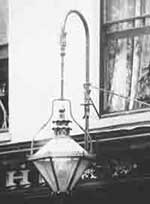
Privately owned gas lamp outside a shop. Detail from a photograph in Farnham Museum.
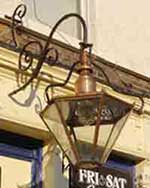
Typical lamp outside a public house. Photo courtesy of Cliff Raven.
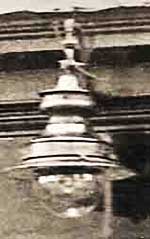
Lamp outside a terraced house used as a draper/ haberdashery shop.
| sources | webmaster | contact |
Text and images are copyright
If you can add anything to this page or provide a photo, please contact me.



